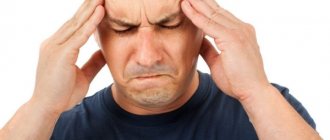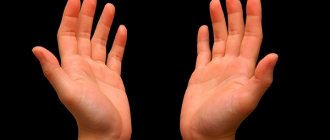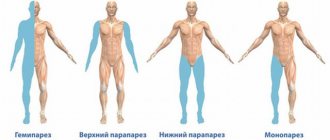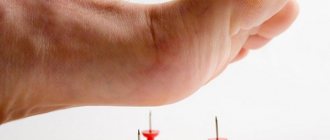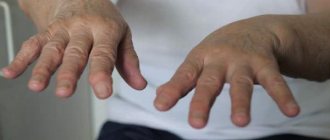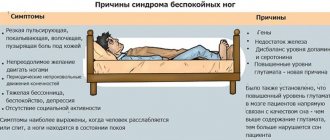Trembling of the limbs is a problem that every person has experienced at least once. Usually it is temporary, but sometimes it can be permanent. Is this condition dangerous? It all depends on how pronounced this phenomenon is. If you feel only a slight trembling of your fingers, then it will not bother you, but some people have such strong hand tremors that it becomes difficult to perform such simple actions as bringing a spoon to their mouth. In addition, it is important to understand that trembling of the limbs is not always harmless. It happens that this condition is a symptom of a disease. Therefore, today we will look at what types of tremor exist and how to treat them.
What is hand tremor: types of problem
Tremor of the limbs is nothing more than their trembling. This problem occurs in every second person, but has varying degrees of severity. In addition, the types of such symptoms differ.
Since tremor can be a symptom of a disease, it is necessary to identify it in time. To better understand whether your hands are shaking, stretch them out, turn them upside down and place a sheet of paper. You can see any tremor from this mark.
Hand tremors can have many different causes. Depending on them, this disease is divided into varieties.
Types of tremor of the upper and lower extremities:
- Physiological or postural tremor is different in that not only the hands, but the rest of the body trembles. The person himself may not always notice such a symptom.
- Accented type tremor occurs due to intoxication of the body, anxiety, overwork and hypothermia. Over time, this condition goes away on its own.
- Essential tremor is a congenital pathology of the human body. Usually it is not very pronounced. In rare cases, it is accompanied by slight torticollis.
- Parkinsonian tremor is absent when moving or concentrating on something. However, when walking and at rest, it intensifies again. Often the cause of this symptom is Parkinson's disease.
- Cerebellar tremor is an inertial trembling of the arms and legs. This problem arises due to the presence of various diseases affecting the cerebellum.
- Rubber tremor is a kinetic and postural tremor, as well as tremors at rest. Usually appears in diseases of the midbrain.
- Dystonic tremor is asymmetrical. It appears in various types of dystonia.
- Neuropathic tremor is associated with various diseases and disorders of the nervous system.
- Intention tremor occurs when attempting to perform a precise movement. Often appears with damage to the cerebellum.
- Asterixis or flapping tremor is characterized by rapid, irregular and involuntary movements. Often occurs with hepatic encephalopathy.
Tremors can occur for a variety of reasons. This phenomenon can be associated with both banal physical or psychological fatigue and serious illnesses. Therefore, if such a symptom appears, you should consult a doctor.
Trembling
I
Trembling (tremor; synonym for tremor)
hyperkinesis, manifested by involuntary rhythmic stereotypical oscillatory movements of various parts of the body due to alternating contraction of antagonist muscles.
A distinction is made between physiological and pathological D. Physiological D. exists in all healthy people and represents irregular vibrations of body parts with an average frequency of 10-12 Hz, which are not perceived visually, since the amplitude of physiological D. is very small. The emergence of pathological D. (see Hyperkinesis) reflects the restructuring of a number of systems involved in the regulation of motor activity (see Movements) and their pathological integration in a new mode. In the pathogenesis of D., an imbalance of neurotransmitter systems—cholinergic, serotonergic, etc.—is important.
Clinically, resting D. is distinguished, which manifests itself during muscle relaxation; static (postural) D., observed in tense muscles; kinetic D., which persists during movement; Intentional D. - a jerky tremor that intensifies during movement when approaching the target. The combination of movements in various muscle groups leads to involuntary rhythmic movements in certain joints in the form of flexion-extension, adduction-abduction, pronation-supination, or more complex rotational movements. D. can cover individual parts of the body (monotype), half the body (hemitype), and the entire body and limbs (generalized type).
D.'s registration is carried out using special filming and photography methods, tremographs of various designs, and electromyographic methods in various modifications.
Trembling is one of the most common symptoms of various diseases of the nervous system, as well as some somatic diseases and intoxications. It is observed in most pathological processes of various etiologies that affect the extrapyramidal system (Extrapyramidal system), the cerebellar system (see Cerebellum), extrapyramidal-cerebellar connections and the reticular formation of the brain stem (see Brain stem).
One of the most common pathological conditions accompanied by D. is Parkinsonism. Parkinsonism is characterized by resting pulses with a frequency of 4-6 Hz, and finger pulses take on a special shape, reminiscent of rolling pills or counting coins. With voluntary movements, Parkinson's D. usually decreases or disappears. With essential tremor (hereditary D.), a symmetrical statokinetic D. is observed with a frequency of 6-8 Hz, often in combination with a weakly expressed intentional D. The trembling form of hepatocerebral dystrophy (Hepatocerebral dystrophy) is characterized by a large-amplitude D. of a statokinetic nature. Its sharp increase during targeted movements often deprives patients of the ability to self-care. Intentional D. is observed in diseases accompanied by damage to the cerebellum and its connections—multiple sclerosis, hereditary cerebellar degenerations, focal processes in the cerebellum, etc. D. is observed in endogenous and exogenous intoxications (thyrotoxicosis, hepatic encephalopathy, alcoholism, morphinism, mercury poisoning, lead, etc.); for neuroses (functional D.).
When differential diagnosis with diseases accompanied by D., one should take into account both the characteristics of D. itself and the accompanying symptoms, course of the disease, anamnesis, and heredity.
D.'s treatment should be aimed at the underlying disease. Symptomatic drugs are anticholinergics (see Anticholinergic drugs), beta-blockers (see Adrenergic blocking drugs), diazepine drugs. In severe cases, surgical treatment is indicated - stereotactic surgery (see Functional neurosurgery).
Bibliography: Vein A.M., Golubev V.L. and Berzins Yu.E. Parkinsonism, p. 54, Riga, 1981; Kandel E.I. Functional and stereotactic neurosurgery, p. 27, M., 1981.
II
Trembling (tremor; syn. tremor)
hyperkinesis, manifested by involuntary, stereotypical, rhythmic oscillatory movements of the whole body or its parts.
Alcoholic tremors (t. alcoholicus) - D. muscles of the face, tongue and especially the spread fingers of outstretched arms, observed in acute intoxication and chronic alcoholism.
Trembling of the “yes-yes” type - static D. in the form of nodding movements of the head.
Dynamic trembling (t. dynamicus) - see Intentional trembling.
Idiopathic trembling (t. idiopathicus) - see Essential trembling.
Intentional trembling (t. intentionalis; synonym: D. dynamic, D. kinetic) - D. that occurs during voluntary purposeful movements and intensifies at the end of the motor act; caused by damage to the cerebellum and (or) its pathways.
Hysterical trembling (t. hystericus) - D. in hysteria, which is constant or paroxysmal in nature, changing rhythm and amplitude, increasing under the influence of psychogenic factors.
Kinetic trembling (t. kineticus) - see Intentional trembling.
Hereditary trembling (t. hereditarius) - see Essential trembling.
Trembling of the “no-no” type is a static D. in the form of head movements from side to side.
Chill-like trembling - D. of the whole body, accompanied by contraction of the hair muscles (“goose bumps”) and a pronounced autonomic reaction (pallor of the skin, etc.).
Parkinsonian trembling (l. parkinsonicus) is a static movement of the hands (in the most typical cases, reminiscent of rolling a bread ball with the fingers), and also often of the head, lower jaw, etc., observed in parkinsonism; characterized by small amplitude and regular rhythm.
Positional jitter - see Static jitter.
Mercury trembling (t. mercurialis) - D. at rest and intensifying with voluntary movements, manifesting itself first in the muscles of the face and spreading to the limbs; observed during mercury intoxication.
Mixed trembling (t. mixtus) - A., appearing at rest and during movement.
Senile trembling (t. senilis) - mixed D., mainly of the head, lower jaw, fingers, which does not have a significant effect on the performance of motor acts; observed in old and senile age.
Static trembling (t. staticus; syn. D. position) - D., observed at rest and stopping during movements.
Physiological trembling (t. physiologicus) - D., arising as a result of muscle tension, fatigue, cooling, or emotional arousal.
Emotional trembling (t. emotionalis) is a physiological movement of the fingers, eyelids, and sometimes the head, which occurs during emotional arousal.
Essential trembling (t. essentialis; synonym: D. idiopathic, D. hereditary) is a hereditary disease characterized by D. of the head and hands, which intensifies with excitement, movements, an attempt to maintain a certain position and stops in sleep; inherited in an autosomal dominant manner.
Source: Medical Encyclopedia on Gufo.me
Meanings in other dictionaries
- trembling - spelling trembling, -I Lopatin's Spelling Dictionary
- trembling - Trembling, trembling, trembling, trembling, trembling, trembling, trembling, trembling, trembling, trembling, trembling, trembling Zaliznyak’s Grammar Dictionary
- trembling - TREMBLING see Trembling. Kuznetsov's Explanatory Dictionary
- trembling - noun, number of synonyms: 21 shudder 10 vibration 13 vibrating 8 hippus 1 trembling 23 iridodonesis 1 cracking 2 nystagmus 2 chills 4 twitching 18 trembling 3 skelotirbia 2 shudder 11 tremolo 3 tremor 3 trembling 27 fluttering 15 trembling gasping 12 fluttering 5 shaking 12 shaker 20 Dictionary of synonyms of the Russian language
- trembling - TREMBLING, trembling, cf. Action under Ch. tremble in 1 and 2 ·digits. Hand trembling. Trembling of the eyelids. Ushakov's Explanatory Dictionary
- trembling - trembling cf. 1. The process of action according to Ch. tremble I 2. The result of such an action. Explanatory Dictionary by Efremova
- trembling - -i, cf. Action according to verb. tremble (in 1 value). Hand trembling. Deck shaking. Trembling flames of the fire. Trembling voice. Small academic dictionary
- trembling - Trembling/a/ni/e [y/e]. Morphemic-spelling dictionary
- jitter - Network Signal distortion that occurs on QDR Infiniband, Fiber Channel (8 Gbps), and Ethernet (10 Gbps) links. It arises due to the dispersion in the delivery time of packets, which by default should have arrived continuously one after another. Dictionary of computer terms
- Blog
- Jerzy Lec
- Contacts
- Terms of use
© 2005—2020 Gufo.me
Causes of hand tremors: what they are and how dangerous they are
There are many causes of tremor. Many diseases are characterized by a similar symptom. Therefore, we will describe only the most common and dangerous ones.
Tremors usually occur in adults and older people. However, this phenomenon can also appear in a teenager. In this case, the tremor is called familial and is considered a consequence of increased emotionality.
As we said, tremors are often seen in older people, but can also occur in teenagers. Therefore, we propose to consider all the main causes of tremor.
Causes of tremor:
- This phenomenon is often observed in various mental disorders. This can be either a serious illness or mental and emotional fatigue.
- Physical fatigue is also included in the list of reasons for this phenomenon. This can be caused by one-time overloads or constant overwork.
- Some medications may have this side effect.
- Hormonal diseases mostly cause tremors. This symptom is typical for high blood sugar levels.
- Alcohol and drug intoxication often causes this symptom. Hand trembling is also possible due to various poisonings. A similar condition is especially often observed with mercury vapor poisoning.
- Diseases such as malignant and benign brain tumors also cause tremors. This includes multiple sclerosis.
- Parkinson's disease, stroke, neuropathy, hypoglycemia and kidney disease are associated with hand tremors.
- Tremor can be hereditary. Also, trembling of the limbs accompanies some genetic diseases.
These are not all the causes of hand tremors. There is a huge list of diseases that cause this condition.
Symptoms and treatment of limb tremor
Limb tremor is considered to be the most common motor function disorder in patients. Quite often, tremor of the limbs develops against the background of unfavorable heredity, while at the same time, in some cases, tremor is malignant in nature and is quite severe.
Symptoms of limb tremor
Tremor of the limbs often begins in children during puberty. Hand tremors develop in one hand, and after some time, symptoms of the disease are noted in the second. Tremors can also affect the head, spreading to the chin and head. In some cases, tremors affect the legs and torso. At the same time, the disease does not interfere with holding a spoon and pen for writing. With excitement and after drinking alcoholic beverages, the tremor becomes more pronounced. Hand trembling is easy to notice if the patient stretches his arms forward; tremor of the larynx and tongue leads to speech impairment, which is also easy to hear when examining the patient.
Postural tremor of the limbs can be inherited; symptoms of the disease usually appear at a time of strong excitement and accompany pathology of the thyroid gland. This type of tremor may be accompanied by withdrawal symptoms when consuming alcohol, drugs, or certain medications. Complications in the form of tremor can be caused by taking medications that increase the volume of the bronchi, some psychotropic drugs, and an overdose of heavy metals. This trembling does not go away when the patient moves, but intensifies when concentrating.
Intention tremor of the limbs develops with pathology of the cerebellum, which is responsible for maintaining balance during movement. This type of trembling of the limbs is accompanied by sweeping motor reflexes that disappear during rest. As part of motivated movement, the tremor worsens. When examined by a doctor, the patient is unable to touch the tip of the nose with his hand with his eyes closed. The most dangerous is considered to be asterixis - one of the types of limb tremors. It occurs against the background of a disease that is inherited, as a result of which copper accumulates in the blood, meninges and liver. In some cases, the pathology is closely related to abnormal functioning of the liver, kidneys, and lungs. Motor functions in such patients reflect uneven flexion and extension of the limbs.
All of the above types of tremor appear relatively infrequently. At the same time, Parkinson's disease is a fairly common pathology, affecting mainly elderly people - over 60 years of age. The tremor that accompanies this disease is considered strong and frequent. Pathology develops over time, and tremor refers only to its initial manifestations. In some cases, trembling of the limbs may be completely absent or insignificant.
Of all the diseases described, it is Parkinson’s disease that causes disability, while at the same time the pathology has no effect on life expectancy.
Treatment of limb tremor
Treatment for limb tremors in adolescents is often unnecessary or unnecessary. If tremors are severe, your doctor may recommend sedatives. Tremor, which begins at a moment of strong excitement and goes away at rest, is usually treated with sleeping pills.
When treating limb tremor in patients with Parkinson's disease, doctors aim to slow down the manifestation of the disease with the help of modern medications. Experts begin to relieve tremor in Parkinson's disease when the patient's performance decreases.
Author of the article:
Mochalov Pavel Alexandrovich |
Doctor of Medical Sciences therapist Education: Moscow Medical Institute named after. I. M. Sechenov, specialty - “General Medicine” in 1991, in 1993 “Occupational diseases”, in 1996 “Therapy”. Our authors
How to treat intention tremor and its other types
Treatment of hand tremor is possible only after a thorough diagnosis. After all, it is impossible to eliminate this symptom without treating the cause.
Do not confuse the concepts of tremor and trimmer. A trimmer is a machine for cutting something.
So, after a thorough diagnosis, the doctor determines the cause of the disease. And only based on it, it begins to solve your problem. Let's see what treatment methods for tremor exist.
Treatment methods for tremor:
- First of all, diet is used. The patient will have to give up coffee, alcohol and smoking, as well as sweet and fatty foods. In some cases, fasting is used.
- For mental causes of tremor, antidepressants are prescribed. In some cases, inhibitors may be required.
- Treatment with bees and leeches are outdated methods of getting rid of tremors. However, in some cases they show high efficiency.
- Water treatment also helps. We are talking about proper drinking regimen, contrast showers and swimming.
- Anticonvulsants for tremor show a good effect. However, they are prescribed in smaller doses.
- If none of the described methods helps, surgical treatment may be used. However, this method is used if hand trembling prevents a person from living fully.
Medical treatments for tremor are quite effective. However, this is provided that the main cause of this phenomenon is eliminated.
Folk remedies against postural tremor
Tremors can only be treated at home if they are caused by fatigue or nerve problems. There are several positions of such treatment.
How to get rid of tremors at home:
- First of all, make sure you get good sleep. You should sleep at least eight hours a night.
- Learn to calm yourself during times of stress. At the moment there are many ways to self-control.
- Before going to bed, you should not engage in activities that excite the nervous system. Give preference to quiet activities.
- Eat so that you get the required dose of vitamins and minerals every day.
- Stretch your arms, walk in the fresh air, go swimming. Yoga classes are also very effective.
- Herbal teas can help you. For example, you can brew a tablespoon of heather in a glass of boiling water and let the mixture, poured into a thermos, sit for eight hours. You need to take this medicine in small sips throughout the day.
Relaxing baths are also effective. You can add herbal decoctions or essential oils to them with a calming effect.

